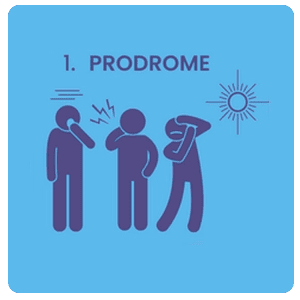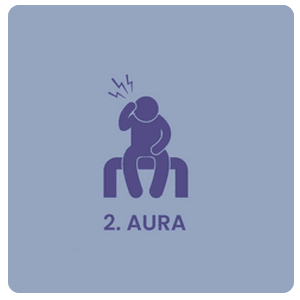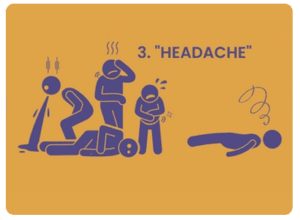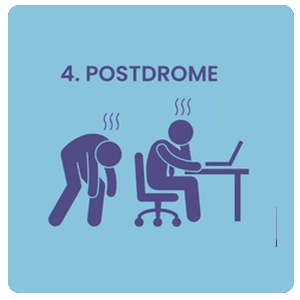Migraine phases

More than ‘just a headache’
Migraine attacks typically include symptoms such as nausea, vomiting, sensitivity to light, sound, smell or touch, fatigue, dizziness, clumsiness and cognitive difficulties – like finding it hard to remember words (or passcodes), think clearly and concentrate.
During a migraine attack, people tend to want to stay still and shut off any sensory input, especially light and sound. Those other symptoms can be as, or more, unpleasant and debilitating as the headache.




Migraine attacks occur in four phases
- Prodrome
- Aura
- Headache
- Postdrome
A full migraine attack can last for days if you count the time before and after the headache phase.
Before the headache phase, you have the prodromal phase, where you may notice food cravings, changes in mood (e.g. irritable or hyperactive), fatigue and lethargy, yawning, brain fog, changes in bowel movements, sensitivity to light, noise or smell and neck stiffness.
Some of these prodromal symptoms were previously thought to be triggers of migraine attacks, but are now considered to be part of the attack itself.
For example, a sugar craving during the prodromal phase can lead people to eat chocolate, which is then blamed for causing the subsequent headache phase. This phase can last for a few hours to several days before the headache starts.
The aura phase is experienced by about 20% of people with migraine. It occurs just before a headache develops, and usually manifests as disturbed vision, such as bright zigzag lines, flashing lights and blind spots. The aura phase typically lasts between 5–60 minutes.
Most people with migraine experience the headache phase. This phase can last between 2–72 hours (sometimes longer). Symptoms include throbbing, pulsating or stabbing pain, typically on one side of the head, but it can be experienced on both.
The pain is worsened by movement, physical activity and simple activities, and people generally prefer to lie still, often in a dark room. Nausea and/or vomiting and sensitivity to sound, light, smell or touch are also typical features of this phase.
After the headache phase, the postdromal phase can linger for a day or more. This is where the head pain has eased but other symptoms linger, including mood changes, fatigue, persistent nausea, weakness, mild head pain and slowed thinking.
If you have chronic migraine, with headaches for 15 days or more a month, these phases can blur into each other and you may experience some kind of migraine symptom most days or every day.
Not everyone with migraine experiences all four phases, and the intensity and duration of each phase can vary widely among individuals. Additionally, some people may experience migraine attacks without headache or may have atypical symptoms.

